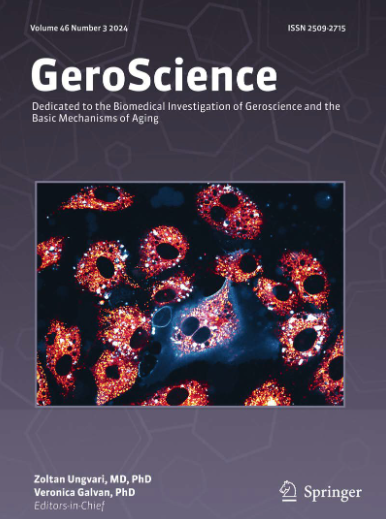Immune cells and inflammatory proteins are differentially associated with subsequent DNA methylation biological aging measures in the Framingham Heart Study Offspring Cohort.
IF 5.4
2区 医学
Q1 GERIATRICS & GERONTOLOGY
引用次数: 0
Abstract
To gain a more comprehensive understanding of the relationships among immunoscenescence and inflammaging, and subsequent epigenetic aging, we measured a panel of 43 immune cell phenotypes and 68 inflammatory proteins collected from blood samples provided by participants in the Framingham Heart Study Offspring Cohort at Exam 7 (1998-2001) and principal component-based DNA methylation (DNAm)-based biologic clocks measured at the subsequent exam (Exam 8 2005-2008), an average of 6 years later. A total of 24 of the 43 immune cell phenotypes and 55 of the 68 inflammatory proteins investigated were significantly associated with at least one of six DNAm aging metrics in age and sex adjusted models. The immune cell associations persisted after accounting for cardiovascular disease and its risk factors, but the protein associations were attenuated. The effects of the inflammatory proteins were larger in the subset of individuals who were < 60 at the protein measurement, compared to those ≥ 60. Immune cell measurements had more associations with age acceleration measures from the 1st generation DNAm clocks and the 2nd generation PhenoAge, while the inflammatory proteins were primarily associated with age acceleration measures based on PhenoAge, GrimAge, and the Dunedin Pace of Aging metric. This study is one of the first attempts to investigate prospective relationships between baseline immune cell composition measured via flow cytometry and inflammatory protein levels and DNAm age measured several years later and represents one of the most comprehensive mappings of immune and inflammatory contributions to DNAm-based age acceleration and pace of aging metrics to date.在弗雷明汉心脏研究后代队列中,免疫细胞和炎症蛋白与随后的DNA甲基化生物学衰老指标存在差异相关。
为了更全面地了解免疫荧光与炎症以及随后的表观遗传衰老之间的关系,我们测量了一组43种免疫细胞表型和68种炎症蛋白,这些血液样本收集自弗雷明汉心脏研究后代队列(1998-2001年)的参与者提供的血液样本,并在随后的检查(2005-2008年)中测量了基于主成分的DNA甲基化(DNAm)生物钟,平均6年后。在年龄和性别调整模型中,43种免疫细胞表型中的24种和68种炎症蛋白中的55种与6种dna衰老指标中的至少一种显著相关。在考虑心血管疾病及其危险因素后,免疫细胞相关性仍然存在,但蛋白质相关性减弱。与≥60的个体相比,炎症蛋白的影响在蛋白质测量时< 60的个体中更大。免疫细胞测量与来自第一代DNAm时钟和第二代PhenoAge的年龄加速测量有更多的关联,而炎症蛋白主要与基于PhenoAge、GrimAge和达尼丁衰老速度测量的年龄加速测量相关。这项研究是首次尝试研究通过流式细胞术测量的基线免疫细胞组成和炎症蛋白水平与几年后测量的DNAm年龄之间的前瞻性关系,代表了迄今为止基于DNAm的年龄加速和衰老指标最全面的免疫和炎症贡献映射之一。
本文章由计算机程序翻译,如有差异,请以英文原文为准。
求助全文
约1分钟内获得全文
求助全文
来源期刊

GeroScience
Medicine-Complementary and Alternative Medicine
CiteScore
10.50
自引率
5.40%
发文量
182
期刊介绍:
GeroScience is a bi-monthly, international, peer-reviewed journal that publishes articles related to research in the biology of aging and research on biomedical applications that impact aging. The scope of articles to be considered include evolutionary biology, biophysics, genetics, genomics, proteomics, molecular biology, cell biology, biochemistry, endocrinology, immunology, physiology, pharmacology, neuroscience, and psychology.
 求助内容:
求助内容: 应助结果提醒方式:
应助结果提醒方式:


